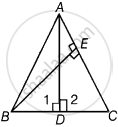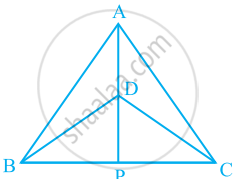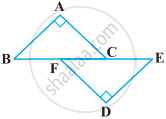Advertisements
Advertisements
Question
ABC is an isosceles triangle in which AC = BC. AD and BE are respectively two altitudes to sides BC and AC. Prove that AE = BD.
Solution
Given: ΔABC is an isosceles triangle in which AC = BC.
Also, AD and BE are two altitudes to sides BC and AC, respectively.

To prove: AE = BD
Proof: In ΔABC,
AC = BC ...[Given]
∠ABC = ∠CAB ...[Angles opposite to equal sides are equal]
i.e., ∠ABD = ∠EAB ...(i)
In ΔAEB and ΔBDA,
∠AEB = ∠ADB = 90° ...[Given, AD ⊥ BC and BE ⊥ AC]
∠EAB = ∠ABD ...[From equation (i)]
And AB = AB ...[Common side]
∴ ΔAEB ≅ ΔBDA ...[By AAS congruence rule]
⇒ AE = BD ...[By CPCT]
Hence proved.
APPEARS IN
RELATED QUESTIONS
ΔABC and ΔDBC are two isosceles triangles on the same base BC and vertices A and D are on the same side of BC (see the given figure). If AD is extended to intersect BC at P, show that
- ΔABD ≅ ΔACD
- ΔABP ≅ ΔACP
- AP bisects ∠A as well as ∠D.
- AP is the perpendicular bisector of BC.

BE and CF are two equal altitudes of a triangle ABC. Using RHS congruence rule, prove that the triangle ABC is isosceles.
ABC is an isosceles triangle with AB = AC. Drawn AP ⊥ BC to show that ∠B = ∠C.
In two right triangles one side an acute angle of one are equal to the corresponding side and angle of the other. Prove that the triangles are congruent.
Prove that in a quadrilateral the sum of all the sides is greater than the sum of its diagonals.
In the following figure, BA ⊥ AC, DE ⊥ DF such that BA = DE and BF = EC. Show that ∆ABC ≅ ∆DEF.

Prove that sum of any two sides of a triangle is greater than twice the median with respect to the third side.
In a right triangle, prove that the line-segment joining the mid-point of the hypotenuse to the opposite vertex is half the hypotenuse.
Line segment joining the mid-points M and N of parallel sides AB and DC, respectively of a trapezium ABCD is perpendicular to both the sides AB and DC. Prove that AD = BC.
ABC is a right triangle such that AB = AC and bisector of angle C intersects the side AB at D. Prove that AC + AD = BC.
